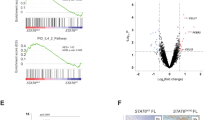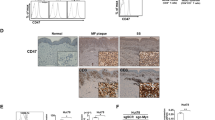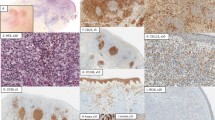Abstract
Interleukin (IL)-31A binds to an heterodimer composed of IL-31 receptor A (IL-31RA) and Oncostatin M Receptor (OSMR). The IL-31/IL-31R complex is involved in the pathogenesis of various skin diseases, including cutaneous T-cell lymphoma. No information is available on the relations between the IL-31/IL-31R complex and B-cell lymphoma. Here we have addressed this issue in follicular lymphoma (FL), a prototypic germinal center(GC)-derived B-cell malignancy. IL-31 enhanced primary FL cell proliferation through IL-31R-driven signal transducer and activator of transcription factor 1/3 (STAT1/3), extracellular signal–regulated kinase 1/2 (ERK1/2) and Akt phosphorylation. In contrast, GC B cells did not signal to IL-31 in spite of IL-31R expression. GC B cells expressed predominantly the inhibitory short IL-31RA isoform, whereas FL cells expressed predominantly the long signaling isoform. Moreover, GC B cells lacked expression of other IL-31RA isoforms potentially involved in the signaling pathway. IL-31 protein expression was significantly higher in surface membrane than in cytosol of both FL and GC B cells. IL-31 was detected in plasma membrane microvesicles from both cell types but not released in soluble form in culture supernatants. IL-31 and IL-31RA expression was higher in lymph nodes from FL patients with grade IIIa compared with grade I/II, suggesting a paracrine and/or autocrine role of IL-31/IL-31RA complex in tumor progression through microvesicle shedding.
This is a preview of subscription content, access via your institution
Access options
Subscribe to this journal
Receive 12 print issues and online access
$259.00 per year
only $21.58 per issue
Buy this article
- Purchase on Springer Link
- Instant access to full article PDF
Prices may be subject to local taxes which are calculated during checkout






Similar content being viewed by others
References
Dillon SR, Sprecher C, Hammond A, Bilsborough J, Rosenfeld-Franklin M, Presnell SR et al. Interleukin 31, a cytokine produced by activated T cells, induces dermatitis in mice. Nat Immunol 2004; 5: 752–760.
Cornelissen C, Brans R, Czaja K, Skazik C, Marquardt Y, Zwadlo-Klarwasser G et al. Ultraviolet B radiation and reactive oxygen species modulate interleukin-31 expression in T lymphocytes, monocytes and dendritic cells. Br J Dermatol 2011; 165: 966–975.
Niyonsaba F, Ushio H, Hara M, Yokoi H, Tominaga M, Takamori K et al. Antimicrobial peptides human beta-defensins and cathelicidin LL-37 induce the secretion of a pruritogenic cytokine IL-31 by human mast cells. J Immunol 2010; 184: 3526–3534.
Ishii T, Wang J, Zhang W, Mascarenhas J, Hoffman R, Dai Y et al. Pivotal role of mast cells in pruritogenesis in patients with myeloproliferative disorders. Blood 2009; 113: 5942–5950.
Siraganian RP . Mast cell signal transduction from the high-affinity IgE receptor. Curr Opin Immunol 2003; 15: 639–646.
Sonkoly E, Muller A, Lauerma AI, Pivarcsi A, Soto H, Kemeny L et al. IL-31: a new link between T cells and pruritus in atopic skin inflammation. J Allergy Clin Immunol 2006; 117: 411–417.
Bilsborough J, Leung DY, Maurer M, Howell M, Boguniewicz M, Yao L et al. IL-31 is associated with cutaneous lymphocyte antigen-positive skin homing T cells in patients with atopic dermatitis. J Allergy Clin Immunol 2006; 117: 418–425.
Raap U, Wichmann K, Bruder M, Stander S, Wedi B, Kapp A et al. Correlation of IL-31 serum levels with severity of atopic dermatitis. J Allergy Clin Immunol 2008; 122: 421–423.
Andoh A, Yagi Y, Shioya M, Nishida A, Tsujikawa T, Fujiyama Y . Mucosal cytokine network in inflammatory bowel disease. World J Gastroenterol 2008; 14: 5154–5161.
Dambacher J, Beigel F, Seiderer J, Haller D, Goke B, Auernhammer CJ et al. Interleukin 31 mediates MAP kinase and STAT1/3 activation in intestinal epithelial cells and its expression is upregulated in inflammatory bowel disease. Gut 2007; 56: 1257–1265.
Lei Z, Liu G, Huang Q, Lv M, Zu R, Zhang GM et al. SCF and IL-31 rather than IL-17 and BAFF are potential indicators in patients with allergic asthma. Allergy 2008; 63: 327–332.
Okano M, Fujiwara T, Higaki T, Makihara S, Haruna T, Noda Y et al. Characterization of pollen antigen-induced IL-31 production by PBMCs in patients with allergic rhinitis. J Allergy Clin Immunol 2011; 127: 277–279, 279e.1–279e.11.
Diveu C, Lelievre E, Perret D, Lak-Hal AH, Froger J, Guillet C et al. GPL, a novel cytokine receptor related to GP130 and leukemia inhibitory factor receptor. J Biol Chem 2003; 278: 49850–49859.
Ghilardi N, Li J, Hongo JA, Yi S, Gurney A, de Sauvage FJ . A novel type I cytokine receptor is expressed on monocytes, signals proliferation, and activates STAT-3 and STAT-5. J Biol Chem 2002; 277: 16831–16836.
Zhang Q, Putheti P, Zhou Q, Liu Q, Gao W . Structures and biological functions of IL-31 and IL-31 receptors. Cytokine Growth Factor Rev 2008; 19: 347–356.
Chattopadhyay S, Tracy E, Liang P, Robledo O, Rose-John S, Baumann H . Interleukin-31 and oncostatin-M mediate distinct signaling reactions and response patterns in lung epithelial cells. J Biol Chem 2007; 282: 3014–3026.
Kasraie S, Niebuhr M, Werfel T . Interleukin (IL)-31 activates signal transducer and activator of transcription (STAT)-1, STAT-5 and extracellular signal-regulated kinase 1/2 and down-regulates IL-12p40 production in activated human macrophages. Allergy 2013; 68: 739–747.
Cornelissen C, Luscher-Firzlaff J, Baron JM, Luscher B . Signaling by IL-31 and functional consequences. Eur J Cell Biol 2012; 91: 552–566.
Diveu C, Lak-Hal AH, Froger J, Ravon E, Grimaud L, Barbier F et al. Predominant expression of the long isoform of GP130-like (GPL) receptor is required for interleukin-31 signaling. Eur Cytokine Netw 2004; 15: 291–302.
Horejs-Hoeck J, Schwarz H, Lamprecht S, Maier E, Hainzl S, Schmittner M et al. Dendritic cells activated by IFN-gamma/STAT1 express IL-31 receptor and release proinflammatory mediators upon IL-31 treatment. J Immunol 2012; 188: 5319–5326.
Ohmatsu H, Sugaya M, Suga H, Morimura S, Miyagaki T, Kai H et al. Serum IL-31 levels are increased in patients with cutaneous T-cell lymphoma. Acta Derm Venereol 2012; 92: 282–283.
Singer EM, Shin DB, Nattkemper LA, Benoit BM, Klein RS, Didigu CA et al. IL-31 is produced by the malignant T-cell population in cutaneous T-Cell lymphoma and correlates with CTCL pruritus. J Invest Dermatol 2013; 133: 2783–2785.
Hartmann EM, Ott G, Rosenwald A . Molecular biology and genetics of lymphomas. Hematol Oncol Clin North Am 2008; 22: 807–823, vii.
Kurtin PJ . Indolent lymphomas of mature B lymphocytes. Hematol Oncol Clin North Am 2009; 23: 769–790.
A clinical evaluation of the International Lymphoma Study Group classification of non-Hodgkin's lymphoma. The Non-Hodgkin's Lymphoma Classification Project. Blood 1997; 89: 3909–3918.
Corcione A, Ottonello L, Tortolina G, Facchetti P, Airoldi I, Guglielmino R et al. Stromal cell-derived factor-1 as a chemoattractant for follicular center lymphoma B cells. J Natl Cancer Inst 2000; 92: 628–635.
Corcione A, Ferretti E, Bertolotto M, Fais F, Raffaghello L, Gregorio A et al. CX3CR1 is expressed by human B lymphocytes and mediates [corrected] CX3CL1 driven chemotaxis of tonsil centrocytes. PLoS One 2009; 4: e8485.
Corcione A, Baldi L, Zupo S, Dono M, Rinaldi GB, Roncella S et al. Spontaneous production of granulocyte colony-stimulating factor in vitro by human B-lineage lymphocytes is a distinctive marker of germinal center cells. J Immunol 1994; 153: 2868–2877.
Dono M, Burgio VL, Tacchetti C, Favre A, Augliera A, Zupo S et al. Subepithelial B cells in the human palatine tonsil. I. Morphologic, cytochemical and phenotypic characterization. Eur J Immunol 1996; 26: 2035–2042.
Fossey SL, Bear MD, Kisseberth WC, Pennell M, London CA . Oncostatin M promotes STAT3 activation, VEGF production, and invasion in osteosarcoma cell lines. BMC Cancer 2011; 11: 125.
Di Paolo D, Ambrogio C, Pastorino F, Brignole C, Martinengo C, Carosio R et al. Selective therapeutic targeting of the anaplastic lymphoma kinase with liposomal siRNA induces apoptosis and inhibits angiogenesis in neuroblastoma. Mol Ther 2011; 19: 2201–2212.
Pagnan G, Di Paolo D, Carosio R, Pastorino F, Marimpietri D, Brignole C et al. The combined therapeutic effects of bortezomib and fenretinide on neuroblastoma cells involve endoplasmic reticulum stress response. Clin Cancer Res 2009; 15: 1199–1209.
Jayachandran M, Miller VM, Heit JA, Owen WG . Methodology for isolation, identification and characterization of microvesicles in peripheral blood. J Immunol Methods 2012; 375: 207–214.
Marimpietri D, Petretto A, Raffaghello L, Pezzolo A, Gagliani C, Tacchetti C et al. Proteome profiling of neuroblastoma-derived exosomes reveal the expression of proteins potentially involved in tumor progression. PLoS One 2013; 8: e75054.
Johnson PW, Watt SM, Betts DR, Davies D, Jordan S, Norton AJ et al. Isolated follicular lymphoma cells are resistant to apoptosis and can be grown in vitro in the CD40/stromal cell system. Blood 1993; 82: 1848–1857.
Cevikbas F, Wang X, Akiyama T, Kempkes C, Savinko T, Antal A et al. A sensory neuron-expressed IL-31 receptor mediates T helper cell-dependent itch: involvement of TRPV1 and TRPA1. J Allergy Clin Immunol 2013; 133: 448–460.
Calvo KR, Dabir B, Kovach A, Devor C, Bandle R, Bond A et al. IL-4 protein expression and basal activation of Erk in vivo in follicular lymphoma. Blood 2008; 112: 3818–3826.
Stott B, Lavender P, Lehmann S, Pennino D, Durham S, Schmidt-Weber CB . Human IL-31 is induced by IL-4 and promotes TH2-driven inflammation. J Allergy Clin Immunol 2013; 132: 446–454 e445.
Lee Y, El Andaloussi S, Wood MJ . Exosomes and microvesicles: extracellular vesicles for genetic information transfer and gene therapy. Hum Mol Genet 2012; 21: R125–R134.
Frey B, Gaipl US . The immune functions of phosphatidylserine in membranes of dying cells and microvesicles. Semin Immunopathol 2011; 33: 497–516.
Raap U, Weissmantel S, Gehring M, Eisenberg AM, Kapp A, Folster-Holst R . IL-31 significantly correlates with disease activity and Th2 cytokine levels in children with atopic dermatitis. Pediatr Allergy Immunol 2012; 23: 285–288.
Thiel S, Behrmann I, Dittrich E, Muys L, Tavernier J, Wijdenes J et al. Internalization of the interleukin 6 signal transducer gp130 does not require activation of the Jak/STAT pathway. Biochem J 1998; 330 (Pt 1): 47–54.
Ross RJ, Esposito N, Shen XY, Von Laue S, Chew SL, Dobson PR et al. A short isoform of the human growth hormone receptor functions as a dominant negative inhibitor of the full-length receptor and generates large amounts of binding protein. Mol Endocrinol 1997; 11: 265–273.
Schuler LA, Lu JC, Brockman JL . Prolactin receptor heterogeneity: processing and signalling of the long and short isoforms during development. Biochem Soc Trans 2001; 29: 52–56.
White DW, Tartaglia LA . Evidence for ligand-independent homo-oligomerization of leptin receptor (OB-R) isoforms: a proposed mechanism permitting productive long-form signaling in the presence of excess short-form expression. J Cell Biochem 1999; 73: 278–288.
Eder C . Mechanisms of interleukin-1beta release. Immunobiology 2009; 214: 543–553.
Acknowledgements
This work was supported by grants from Associazione Italiana Ricerca Cancro (A.I.R.C.), Milano, Italy to VP (No. 13003), from Cinque per mille IRPEF–Finanziamento Ricerca Sanitaria and from Ricerca Corrente Ministeriale. EF is a recipient of a Fondazione Umberto Veronesi fellowship. We thank Dr Francesco Bertoni for help in discussion. European Union Seventh Frame Programme (FP7/2007-2013) under grant agreement N° 278570 to DR.
Author information
Authors and Affiliations
Corresponding author
Ethics declarations
Competing interests
The authors declare no conflict of interest.
Additional information
Supplementary Information accompanies this paper on the Leukemia website
Rights and permissions
About this article
Cite this article
Ferretti, E., Tripodo, C., Pagnan, G. et al. The interleukin (IL)-31/IL-31R axis contributes to tumor growth in human follicular lymphoma. Leukemia 29, 958–967 (2015). https://doi.org/10.1038/leu.2014.291
Received:
Revised:
Accepted:
Published:
Issue Date:
DOI: https://doi.org/10.1038/leu.2014.291
This article is cited by
-
IL-31, itch and hematological malignancies
Clinical and Molecular Allergy (2021)
-
Correlation of IL-31 gene polymorphisms with susceptibility and clinical recurrence of bladder cancer
Familial Cancer (2018)



